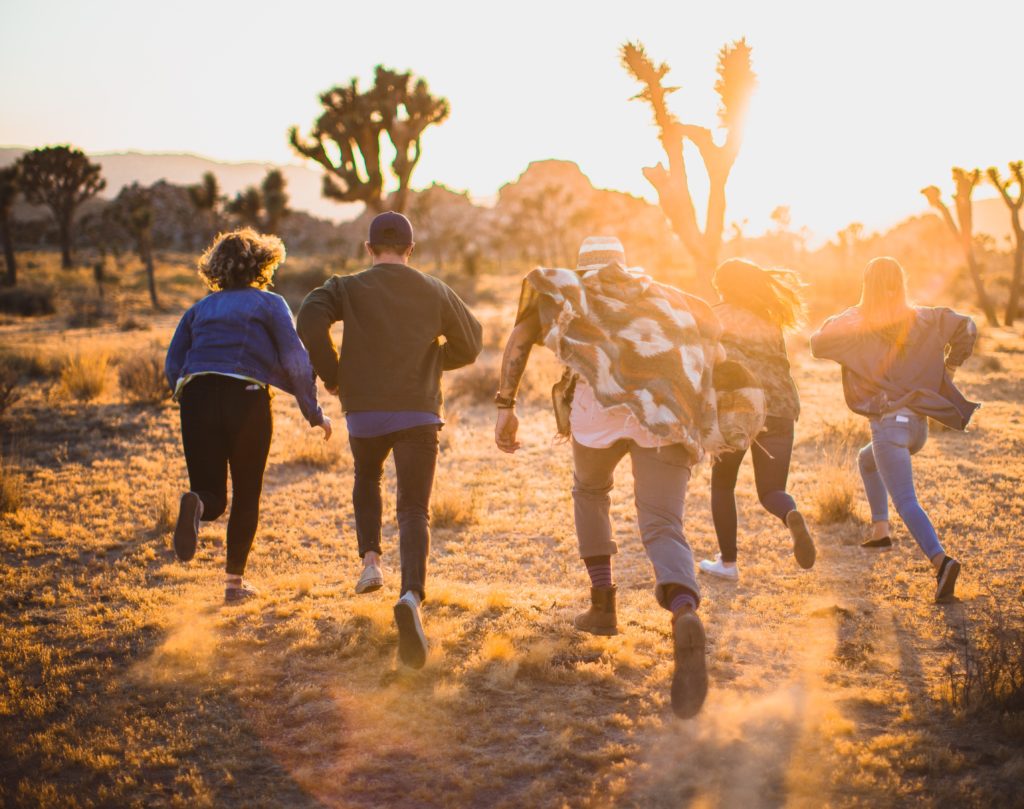I have always struggled to find my tribe. My squad of Ride or Dies, my BAEs, my peeps.
In theory, I understand the benefits of community—connection to a cause greater than yourself combined with acceptance just as you are. But my historical experience in crowds has evoked different sensations—namely, status anxiety, uncertainty about my role, and hopeless frustration at keeping up with the group chat.
For many years, I dealt with these feelings by isolating, adopting the tagline I like books more than people. Recent adventures in sorting out my values, however, have revealed an inconvenient truth: My desire for self-actualization and societal reform seem to require interaction with other humans.
As a result, I have begun tiptoeing back into community, using the theory of positive disintegration (TPD) as my guide. The concepts of overexcitabilities and factors of development helped me understand why I had been choosing the wrong tribes, and feeling alienation, rather than connection, as a result. Fortunately, disintegrating and progressing through Dabrowski’s levels has spurred clarity about my authentic ideals, making it easier to find healthy folks who share my values.
I share both my misadventures and hard-won lessons in the article below.
My Historical Misadventures in Community
It seems safe to say that my historical struggle to find community stemmed from the common one-two punch of first and second factor tendencies. By first and second factors, I mean that potent combo of nature (genes and physiology) and nurture (social and environmental factors).
To set the second factor scene, I grew up in a two-parent family in a well-to-do suburb. Though we were not the wellest-to-do, my material needs were met and exceeded. Lunches were lovingly packed, soccer practice pick-ups on time.
Unfortunately, my genetic endowment thwarted my ability to adjust to this setting. I was overexcitable from the jump, blessed with the litany of ‘em. Fabrics other than cotton rendered me inconsolable, as did any mention of petty crime on the local news. Falling asleep each night took hours as my nervous system processed the events of the day.
Despite the material abundance in my early environment, complete attunement to my sensitivity was in shorter supply. Elders and peers struggled to grasp how Disney—But it’s the happiest place on earth!—could trigger discontentment. Lacking deep mirroring, I never learned to identify (and thus regulate) my intense emotions. Instead, I turned to binging pizza Lunchables and library books to disassociate from the overwhelming world. As others in my social circle seemed to function without such issues, I developed deep shame that I was both too much and not enough. To counteract further rejection, I began a quest to pretzel myself into the dominant standards of decorum. Then, I reckoned, I would be worthy of love.
From my adolescence to my mid-twenties, I lived in a state of insecurity-driven unilevel disintegration. I believed that I was the problem, and if I could just sit still and look pretty enough, I would finally receive the affirmation I so desperately sought.
In late 90s Middle America, the heyday of the pop princess, the dominant standards afforded status to girls who were rich, sexy, submissive, and “cool.” With braces, bifocals, and regular emotional breakdowns, I did not exactly meet those ideals. But golly, did I try. I donned the spaghetti-strap tank tops and watched MTV in attempt to mimic the conduct of the popular kids. Although this posture felt inauthentic and uncomfortable—it involved changing out of my beloved soft pants—I did not know alternative paths existed.
And so, from my adolescence to my mid-twenties, I lived in a state of insecurity-driven unilevel disintegration, level II in the parlance of TPD. I believed that I was the problem, and if I could just sit still and look pretty enough, I would finally receive the affirmation I so desperately sought. Under the influence of these cultural values, I made ill-fitting life decisions, matriculating at a Greek life-oriented college, pursuing a career in New York City’s financial services industry.
Not surprisingly, I struggled to connect with most of the individuals in these communities—a reality that worsened with age. At corporate card-fueled happy hours in midtown Manhattan, I’d nod attentively as intoxicated VPs boasted about investment performance. Although the conversation was banal, it was the aftermath of the financial crisis, and I was driven by the belief that money equaled security and I should be grateful to have a job.
Periodically, I would find people in those settings with whom I related—other outsiders. Beneficiaries of the open bar, we’d huddle and mock the office politics, scoffing to compensate for our feelings of inadequacy. Deeper investigation would reveal we had little in common aside from our out-group status, but this level II trauma-bonding felt more authentic than the level I colloquies of our colleagues. Besides, it was the best I could get at the time.

When It Gets Painful Enough, You’ll Change
After several years of pursuing the yuppie-par-excellence lifestyle, I cried uncle. None of its perks—the $17 cocktails, Michelin-starred establishments, boutique fitness joints—could relieve the existential dread that had taken up residence in my sternum. One January night, Sunday scaries in full force, the Universe intervened and presented the term “spiritual bankruptcy.” The second I heard it, I knew it applied. Shortly after, I learned another useful phrase that directed my behavior: When things get painful enough, you’ll change.
So began my upward journey toward level III, spontaneous multilevel disintegration, with the realization that money and social approval would never fill the hole in my soul. Increasingly, I became willing to sacrifice material comfort for authentic expression. Yes, following these values would require overhauling my entire life—worldview, social circle, spending habits—and perhaps confronting some historical trauma. But the prospect of finding a purpose greater than gratifying my whims seemed preferential to the status quo of despondency, despite the financial risk and discomfort associated with change.
Begrudgingly, I came to recognize that I couldn’t evolve without help, that I needed to surround myself with like-minded folks to hold me accountable.
Initially, I attempted to go it alone. Armed with my library and health insurance cards, I devoured titles like The Neurotic Personality of Our Time and The Feeling of Meaninglessness. I found a therapist. I did core values identification exercises, wrote affirmations, learned knitting and watercolor painting. I reread old papers and perused faded photographs, seeking clues into the person I was before shame compensation and cultural conditioning became the primary drivers of my personality.
These exploratory efforts yielded insights about my priorities: constant learning, creative problem-solving, and inequality reduction. But despite the newfound clarity, I kept backsliding into my old habits of abusing substances, binge-reading lifestyle blogs, and bemoaning my clogged pores and the indifferent universe. Such reversions spurred shame and guilt. Yes, I had identified my core values, but I was also constantly violating them. Apparently (as those who have studied TPD often observe), recognizing that there’s a higher path doesn’t mean you’ll follow it.

Begrudgingly, I came to recognize that I couldn’t evolve without help, that I needed to surround myself with like-minded folks to hold me accountable. I believed that I had undertaken sufficient self-work to start playing nice with others. But the question remained: How to find those who could best support my growth?
Finding One’s Tribe: A Primer
I’ve heard it said that you become the average of the five people with whom you spend the most time. Unfortunately, I’ve heard less about how to consciously craft that squad. Inertia and convenience seem most often to govern the process. Friendships develop with lacrosse teammates or fellow moms at pre-school drop-off.
As most of my historical relationships were proximity-based and one-on-one, I needed to make a concerted effort to master the art of intentional community building. I thus embarked on my “Are You My People?!” world tour, and, through much trial, error, small talk, and free hors d’oeuvres, extracted some learnings.
1. Identify Behavioral and Cultural Ideals
By reflecting on my history, I had gleaned what kinds of groups I did not enjoy—transactional, gossipy ones that evaluated members’ worth by job title, BMI, and/or Instagram follower count. However, I remained unclear about what, in the positive sense, I was seeking.
The only way to figure that out was the ol’ guess, test, and revise method. After joining several running clubs, meditation groups, art classes, volunteer advisory boards, and more, I became clearer on the types of people that provided equal parts stimulation and grounding.
They were multifaceted and open. Since my early days overwhelming folks with my too muchness, I yearned to find a group that would welcome and affirm my overexcitablities, not require me to hide them. In my “Are You My People?!” world tour, I gravitated to multi-faceted individuals who could converse about pop culture, physics, and political economy. I relished those who balanced masculine and feminine traits and knew their way around both yoga studios and Home Depot. Following their example, I began the process of exposing long-buried parts of personality—especially those parts that felt vulnerable to share.
I yearned to find a group that would welcome and affirm my overexcitablities, not require me to hide them. Following their example, I began the process of exposing long-buried parts of personality—especially those parts that felt vulnerable to share.
They were intellectually overexcitable AND humble. For decades, running my mouth about half-formed theses to disinterested parties represented my primary mode of interaction. Imagine my thrill to discover another model of behavior, to find knowledgeable people who loved debate, but also admitted the limits to their understanding—without shame! These people showed me it was okay to say “I don’t know,” and taught me it was possible to connect from the heart and brain at the same time. Revolutionary!
They had self-awareness and self-esteem. In my journey, I came to realize the value of finding connections who had “done the work” to both discover their authentic self and own it. I felt inspired by those who had endured adversity and disintegration, blossoming into grounded, honest humans with a sense of the absurd (Dabrowski’s level IV). Hearing their stories instilled confidence that I, too, might one day develop a backbone.
They were, in some fashion, spiritually oriented. I once heard the quote that “you can tell a person’s level of spiritual development by how loved you feel in their presence.” The phrase captured the qualities I was seeking—compassionate, non-transactional people who directed their lives toward benefitting others. This abundance-based approach was a welcome change from the scarcity-minded worldview that dominated many of my social settings.
2. Check My Motivations and Listen to My Body
Given my history of abiding by social norms rather than my own wisdom, I knew I had to interrogate my motivations for joining a group. Was I interested in assembling because the members could further my social ambitions? Or because I genuinely shared the vision and had something to contribute?
A key tool for assessing suitability was taking time to check-in with my body. When preparing for a meeting, was I flooded with dread that I had nothing to wear, or did I feel comfortable in my last-season sweater? Upon returning home, did I enjoy the tingle of warmth and connection, or eat a bag of Goldfish crackers and binge read the news to off-gas the anxiety? Although I was sometimes slow to admit it, relapsing into compulsive behaviors provided a reliable clue that I had not, in fact, found my tribe.
3. Stick to It (and Find a Role)
Toward the beginning of my quest, I received a vital piece of advice: attend at least six meetings of any group I was considering joining. This wisdom countered my natural tendency to try something for five minutes, then drop it because I felt uncomfortable. When venturing into new settings, buying a class package or one-month subscription encouraged my repeat attendance. I became familiar with names and faces, which in turn provided the foundation on which deeper connection could be built.
Finding a role within the group was another accountability strategy. If I volunteered to lead a sub-committee or bring snacks, I was obliged to stick around long enough to make a measured decision as to whether the group was a good fit. Working on medium-stakes projects also helped me foster appreciation for diverse perspectives and the value of teamwork—qualities I had historically shunned in my isolationist lifestyle.
Make Sure Your Community Is Healthy
For better or worse, my whole experience in community is largely summarized by the old chestnut: Before you diagnose yourself with depression or low self-esteem, first make sure that you are not, in fact, just surrounded by assholes people in levels I and II.
Before you diagnose yourself with depression or low self-esteem, first make sure that you are not, in fact, just surrounded by people in levels I and II.
After considerable trial, error, and psychotherapy (auto- and otherwise), I’ve come to realize how my overexcitable nature coupled with early invalidation led me to create a false self, a persona which sought love and security through fitting in to the dominant culture.
I’ve also learned that the journey toward Dabrowski’s level V is difficult, perhaps impossible, to undertake alone. Rather, it requires support, modeling, and mirroring from a community of loving people who share the commitment to personal development—and have ideally reached level IV themselves.

Ultimately, although I’ve made great progress, I am still seeking the group that feels truly like home. While virtual communities have provided helpful direction, my ideal tribe would be local. Together, we could design zero-waste jumpsuits, produce subversive pop albums, or train for marathons while sharing podcast recommendations. Bonus points if this new squad has experience in new-to-me parts of town and can bring other pro-social creative types to the party.
I guess what I’m saying is, if anyone out there wants to form a Third Factor: Mid-Atlantic chapter, do hit me up. Just, please, not via a group chat.
Header image courtesy Dmitry Molchanov / Shutterstock




